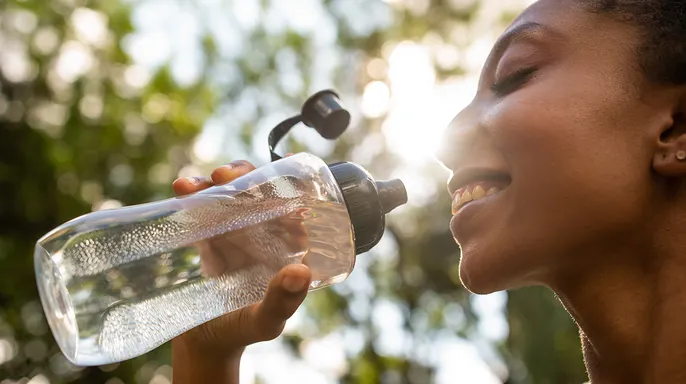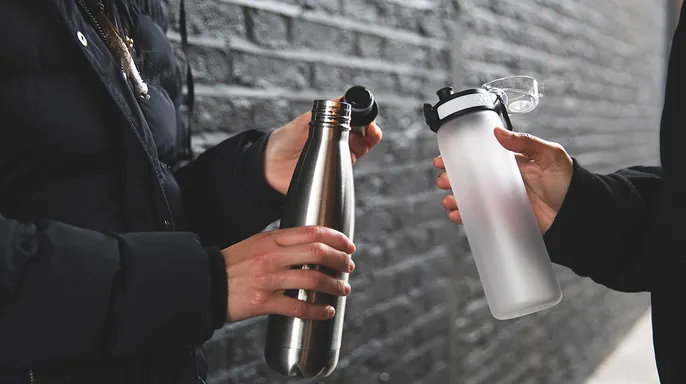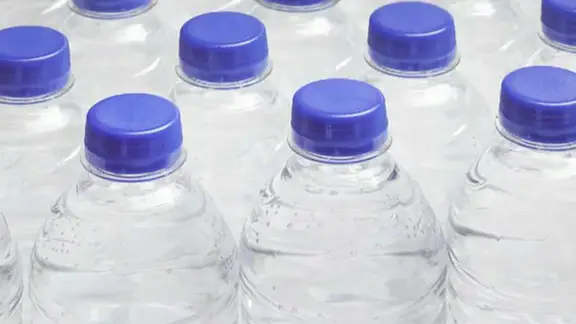Research reveals an exponential amount of germs present in reusable bottles.
Making the sustainable decision to carry around and drink from reusable water bottles might not be the cleanest choice ever.
Reusable water bottles hold 40,000 times more bacteria than toilet seats, a recent study from WaterFilterGuru of Denver, Colorado, revealed.
After swabbing several different reusable water bottles (and different parts of the bottles), researchers found two types of bacteria present — gram-negative rods and bacillus.
Gram-negative rods are commonly associated with hospital-acquired infections and are increasingly becoming resistant to antibiotics, the study noted.

Bacillus can potentially be helpful as a probiotic, but it can also be food-spoiling and disease-causing, and can lead to gastrointestinal issues.
Reusable water bottles held an average of 20.8 million CFUs, or colony-forming units, which estimates the number of living microbes on a sample.
Of all the water bottle types, those with spout-top and screw-top lids contained the most bacteria, with 30 million CFUs each, the study found.
Researchers discovered the same number of CFUs after testing a tap water faucet as well.

The research team at WaterFilterGuru, the organization says, “focuses on the latest in water quality, pollution and residential water treatment. The quality and safety of water varies widely by region, city and even neighborhood.”
It adds on its website that it partners with “research institutions and other organizations” to increase Americans’ “awareness and understanding” of water quality.
While comparing water bottles to sink taps, the group compared reusable bottles to other household items as well.
Bacteria is one of four pollutants that may be present in water coming out of taps, the study reported, even though U.S. tap water is considered among the safest compared to tap water in the rest of the world.
While comparing water bottles to sink taps, the group compared reusable bottles to other household items as well.
This included toilet seats, which hold an average of 515 CFUs — that’s 40,000 times less bacteria than most water bottles were found to have.
Specifically, squeeze-top water bottles had 6,000 times the bacteria of a toilet seat.
On average, reusable water bottles had 14 times the bacteria of a pet water bowl and five times that found on a computer mouse.
A spout-top water bottle had three times the bacteria of a kitchen sink — and kitchen sinks have been known to be the most germ-filled surface in most houses, the study said.
After surveying 1,000 Americans, the researchers found that about 13% clean their water bottles only a few times per month, yet 88% “care deeply” about the quality of their drinking water.
Members of Gen Z reportedly clean their water bottles the least, with 16% only cleaning their bottles a few times a month.
More than 60% of study respondents said they washed their bottles once or more per day.
Cleaning expert Brandon Pleshek, based in Wisconsin, told Fox News Digital that one of the best ways to ensure that a water bottle is getting a good cleaning is by simply using Dawn dish soap and warm water.
To thoroughly disinfect germ-ridden bottles, Pleshek suggested filling up the bottle with warm water and dropping in a denture tablet.
After about 10 minutes, the bottle can be rinsed out and is ready for use.
It’s best to use this disinfecting method about once a week, he recommended.
Experts also suggest washing a reusable water bottle once a day and sanitizing it at least once a week, according to the study.
Sanitation should be increased if there is something other than water in the bottle, if it’s used while eating or if the bottle user has been sick, the researchers noted.
Reusable water bottle users should check their bottles if they’ve been feeling under the weather, noted the study; the culprit may be bacteria and mold build-up inside the bottle.
Immunologist Dr. Purvi Parikh of New York City told Fox News Digital that the risk of bacteria exposure varies from “person to person,” but it can be especially dangerous for those who are immunocompromised or prone to infections.
“This also includes people who have cancer, diabetes, heart disease, lung disease and [the] elderly,” she wrote in an email.
Reusable water bottles should be washed daily with each use, just like any other used plate or cup — and people should pay close attention to hard-to-reach crevices such as caps and straws, Parikh also said.
“Many [people] underestimate how dirty water bottles get,” she added. “Since the bottles just [hold] water… people assume it’s always clean.”
Says WaterFilterGuru.com, “Moist environments are breeding grounds for germs. That’s why washing a reusable water bottle you drink from every day should be part of your daily routine.”

















![EC Announces Elimination of Indelible Ink in Upcoming Elections [Video]](https://newsonghana.com/wp-content/uploads/2023/12/image-351-218x150.png)






































![“Come And Carry Mahama’s E-block Away, If You Won’t Open It” – Yilo Krobo Chief To Akufo-Addo [video]](https://newsonghana.com/wp-content/uploads/2021/10/Yilo-Krobo-Chief-100x70.jpg)